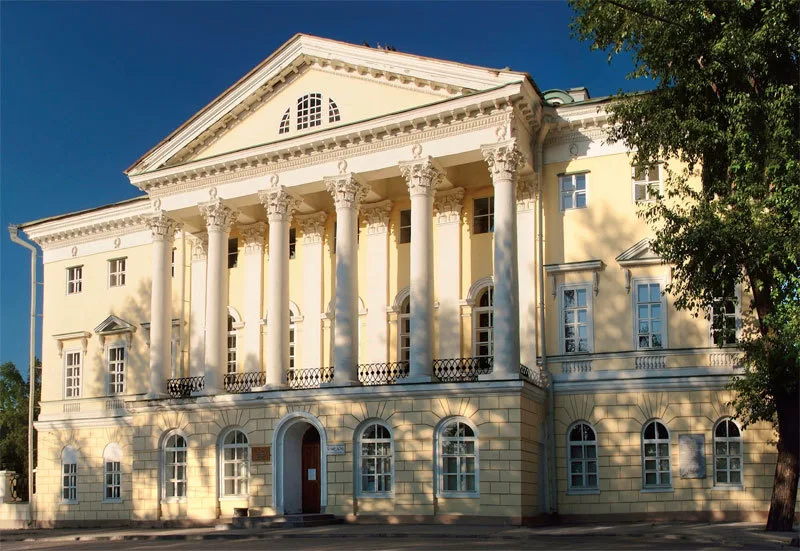Polish Church
The brick, Roman Catholic Church was built on the site of the burned down wooden church of the Assumption of the Blessed Virgin Mary, whose parishioners were mainly exiled Poles who were exiled to Siberia after the uprising in 1830. Work continued from 1881 to 1884. This church is the only building of the Gothic architectural style in Irkutsk. After the restoration, the organ hall of the Irkutsk Philharmonic Society was opened in the Polish Church.
 |
| Polish Church Landmark of Irkutsk |
White House in Irkutsk
The house was built by the sons of the Irkutsk merchant Sibiryakov in 1804. This building soon became known as the Sibiryakov Palace. The White House has been the richest and most majestic building in Irkutsk for over 100 years, and even now it makes an indelible impression on travelers. In 1837, the building was purchased as a residence for the Governor - General of Eastern Siberia. Since 1939, the White House has been serving as a scientific library of Irkutsk State University.
 |
| White House Irkutsk Tours in Eastern Siberia |
Monument to Alexander III
The Monument to Alexander III was erected in 1908 in honor of the completion of the construction of the Siberian railway. The area around the monument has become one of the city's favorite public recreational areas. In 1920, the bronze sculpture of the emperor was removed from the pedestal. ESSD pledged to restore the monument to the 100th anniversary of the Transsib, which was done in 2003, the emperor again took his place on the pedestal.
The monument consists of the figure of Alexander III, standing on top of a pedestal. The pedestal made of red Finnish granite is decorated with sculptural portraits of three people who were directly involved in the conquest of Siberia: Ermak (date of birth unknown - 1585), the chieftain of the kosh. He did a lot with his campaigns of 1581-1585 to annex Siberia to Russia. Mikhail Speransky (1772-1839), Russian statesman, count, author of many bills and reforms in the early 19th century. In 1819 he was appointed Governor-General of Siberia, where he initiated a reform in the management of the region.
Upon returning to St. Petersburg in 1821, he became one of the founders of the Siberian Committee for Russian Affairs beyond the Urals. Nikolay Muravyov-Amursky (1809-1881), Count, Russian statesman, diplomat. As governor of the Yenisei province, governor-general of Eastern Siberia between 1847 and 1861, he did much for the development and study of Eastern Siberia. He contributed to the development of the region, the expansion of trade with the support of geographical and exploration expeditions, and was also an emissary of Russia and signed a Treaty with China in 1858.
 |
| Monument to Alexander III |
Irkutsk Drama Theater
Another architectural Landmark of Irkutsk is the Irkutsk Drama Theater. It was built by the architect Schreter in 1897, who, before the Irkutsk Drama Theater, designed the Mariinsky Theater in St. Petersburg and theaters in Kiev, Nizhny Novgorod, Tbilisi, the Odessa railway station and many other buildings. The theater was built in the style of classicism with donations from merchants and government officials of the city, at the initiative of Governor - General Goremykin. It is one of the oldest drama theaters in Russia.
 |
| Irkutsk Drama Theater |
Znamensky Monastery
The Eternal Flame in Victory Square has a good pedestrian bridge across the street leading to the Angara River. The bridge offers a wonderful view of the sparkling white church, surrounded by a high wall on the riverbank. This is the Znamensky Women's Monastery, and on its territory there is the Cathedral of the Znamenskaya Church.
The Znamensky Monastery was founded in 1683 and the stone church was built at the end of 1762. Lovers of architecture will undoubtedly pay attention to its decorative bell tower and exquisite interior. Its wooden iconostasis and old icon frames created by the hands of Irkutsk carvers and icon painters have remained intact for over 300 years. You can see the old Gospel, which was sent as a gift to Irkutsk by Peter the Great in 1708.
 |
| Znamensky Monastery Irkutsk |
Church Of The Savior Of The Holy Face
One of the oldest churches in Irkutsk is Spasskaya, it was erected within the Irkutsk Kremlin, on the site of an older wooden church in 1708. The Church of the Savior, at that time, was the first stone church in the city, and in our time it is the oldest church in Eastern Siberia and the Far East.
The chronicle says that this church was built thanks to the efforts of the governor of the Irkutsk district, Alexei Sidorovich Sinyavin, with monetary donations from the townspeople. The altar of the Savior was consecrated on August 1, 1710. Unfortunately, the chronicle does not give the name of the builder of the church, but its contemporaries still admire its strict proportions, intricate decor, decorative windows and skillful decoration. In 1758, a bell tower was added to the Church of the Savior. The restoration of the Church of the Savior was completed by Irkutsk craftsmen in 1981.
 |
| Church Of The Savior Of The Holy Face |
Kolchak in Irkutsk
Have you heard of Admiral Kolchak? If yes, then pay attention to the building on the left, just at the intersection of Karl Marx and Lenin streets you will see the former headquarters of the counter-revolutionary army led by Admiral Kolchak during the civil war. If you are interested in more places associated with this person, then you can get acquainted with the Church of the Archangel Michael, where he got married, a two-story wooden building on Marata Street, where he lived, and also visit the place where he was shot on the Ushakovka River in 1920...
 |
Kolchak in Irkutsk |
